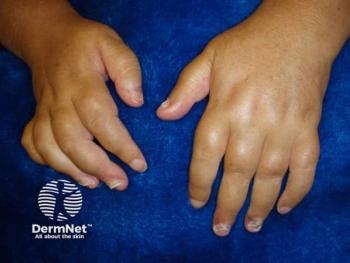
Factors to Consider when Treating PP
Lauren Miller, MPAS, and Tj Chao, MPAS, discuss key factors to consider for plaque psoriasis (PP) treatment.
Episodes in this series

Transcript
Lauren Miller, MPAS, PA-C: Let’s talk about what our approach is for plaque psoriasis when we are looking at caring for these patients. Specifically, what factors do you consider when you’re trying to choose a therapeutic option for them?
TJ Chao, MPAS, PA-C: Well, the patient is the most important aspect to that question.
Lauren Miller, MPAS, PA-C: I agree.
TJ Chao, MPAS, PA-C: Having a conversation with the patient and trying to gain understanding of what they’re willing to do, what they want to accomplish, what’s their goal, how do they define success [is important]. At the end of the day, it really doesn’t matter how we define success. We can look at a body surface area of 0, IGA [Investigator’s Global Assessment score] of 0, but when the patient is not happy, or if the patient is happy and they still have some disease, that’s what really matters to them. How it affects them in their daily lives is what’s important.
Lauren Miller, MPAS, PA-C: I totally agree with that. I think sometimes as providers we have to think beyond what we see on the skin. We also know obviously that there are some symptoms that maybe we can’t visualize. We can’t visualize the itch, we can’t visualize how that affects the patient [mentally]. And so, one of my favorite questions I like to ask my patients is, “How does your disease affect your life? What does it prevent you from doing?” I ask that to every patient, and I ask it at every visit. My goal is to write down that initial response, and when I ask them that again at each visit, I want them to be able to say it’s not affecting anything [and] they’re able to do whatever they want. That allows me to see whether they’re truly happy.
TJ Chao, MPAS, PA-C: I think what we’re really trying to achieve when treating these patients is to give them a sense of freedom from their disease. I can tell you, when I first started practicing that was not an easy achievement.
Lauren Miller, MPAS, PA-C: It was impossible.
TJ Chao, MPAS, PA-C: Nearly impossible. Quite frankly, back then, having patients come into the practice, and in the middle of day having a patient with psoriasis back in 2000 or 2001, it was a real difficult situation. It was not easy to treat; I didn’t have a lot of options. But now, to have what we have today, it’s kind of amazing how far we’ve come and what we can offer these patients. It’s like nothing before.
Lauren Miller, MPAS, PA-C: You’ve been practicing in dermatology a bit longer than me, and I know what was available to me when I started practicing. Even with [the tools I had], the idea of getting someone completely clear was not a possibility. I [can imagine] that when you first started, it definitely wasn’t a possibility.
Transcript edited for clarity.
Newsletter
Like what you’re reading? Subscribe to Dermatology Times for weekly updates on therapies, innovations, and real-world practice tips.




































